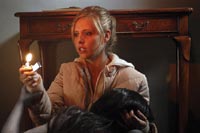 |
It is said that some filmmakers make the same movie over and over, and in Takashi Shimizu’s case, this wouldn’t be hyperbole. More than half of the eight films and straight-to-video releases credited to him at the Internet Movie Database are variations on a single theme—the notion that, when people die in a state of extreme rage or sorrow, the place of their death becomes tainted by a curse that kills everyone who comes near—and if The Grudge is anything to go by, each film contains within itself variations on those variations. Shimizu’s newest film is actually the second remake in a series that began in 2000, with the video Ju-on: The Curse and its sequel. This was followed by the theatrical film Ju-on: The Grudge, which had a brief run in American theaters earlier this year, and yet another sequel. And now, Shimizu has directed another remake, this time in English.

Produced by Sam Raimi, who once made horror movies of his own before he got entangled in the affairs of a certain blockbusting webslinger, The Grudge is the first film to take advantage of the new interest in Japanese horror films—or at least their Americanized remakes—that was sparked a couple of years ago by The Ring. And it is significant that Shimizu, in his latest return to the well, has kept the story as close to its cultural roots as possible, as if to remind those who follow him to respect the cinematic tradition upon which they draw. By keeping this version of The Grudge set in Japan, Shimizu also adds an extra level of tension and apprehension, since most of the protagonists this time around are from the United States and are unfamiliar with the ghosts and spirits that haunt Japanese folklore.
Alas, the film’s mysterious sense of otherness quickly gives way to a sense of familiarity. The Grudge is structured like a series of vignettes in which various characters enter a house, sense something odd, walk down a hall, encounter something spooky, and so on, and the recurrent plot points and camera angles quickly become rather repetitive. What’s more, these brief encounters do not allow the viewer to get to know any of the characters all that well, and since they are all doomed in one way or another—they are, in a sense, human props for each sequence’s big “gotcha!” moment—we don’t have much incentive to identify with them. Perhaps the point of all this is to encourage the viewer to identify not with the victims, but with “the grudge” itself—to see these people not as persons but as mere interchangeable objects of wrath, stumbling ignorantly toward their destruction.

But if the curse itself is supposed to be rooted in intense human emotions, then it certainly would have helped if the film had put more effort into developing its characters. Instead, Shimizu settles for formal tricks like showing the sequences out of chronological order. This keeps us guessing about the origins of the curse—though there’s nothing particularly earth-shattering about the explanation when it arrives—and it also allows Sarah Michelle Gellar, whose previous encounters with things that go bump in the night include everything from the Buffy the Vampire Slayer TV series to the Scream and Scooby-Doo franchises, to appear at several points between the beginning and end of the film; had it told the story sequentially, all her scenes would have been bunched up in the second half.
Gellar plays Karen, an American home-care nurse in an oversized sweater who fills in for a missing Japanese colleague and quickly runs into the ghosts haunting their place of work. When dead bodies and a human jawbone turn up in the attic, and the police officer overseeing the case tells her about the traditions regarding such curses, Karen begins to research the house’s earlier victims, and there is a fascinating sequence in which she seems to step back in time and witness another victim’s discovery of the events that led to this particular curse; what’s even eerier is that Peter (Bill Pullman), the man she spies, seems to sense her watching him from the future, too, though he cannot actually see her.

In moments like these, Shimizu shows that, while he may not care much about the people in his film, he does have a fairly good instinct for those things which send shivers down our spines and get us thinking about the invisible world and our interactions with that reality. Indeed, as a pure, light, PG-13 thrill machine—the sort of film that startles us every now and then with ghostly faces in the window, or freaks us out at the thought of what might be under the covers with us—The Grudge is fairly successful. But it is not especially memorable; and while the film might have something to say about how our own grudges—or for that matter, all the evils we commit—affect the lives of others, it does not press these themes all that hard. The spirits depicted herein might never forget the events on display, but we almost certainly will.
Talk About It
Discussion starters- The Bible includes stories of holy places where the spiritual world touches the physical world, e.g., the place where Jacob dreamed (Genesis 28:10-22) or the Temple’s Holy of Holies. Do such things still happen? Given Peter’s experience at the Transfiguration (Mark 9:1-8), what should our attitude be?
- What about unholy places, where demons intersect the physical world? Any examples from the Bible? Are demons ever tied to geography or a particular place? Do they ever leave a “stain,” like the movie suggests?
- What do you think the movie says about relationships and the ways in which people are affected by each other’s actions?
The Family Corner
For parents to considerThe Grudge is a story rooted in Japanese beliefs about ghosts and spirits, and it is rated PG-13 for mature thematic material, disturbing images/terror/violence, and some sensuality. There are non-explicit references to one character’s adulterous thoughts and to the sex life of Karen and her boyfriend, and there are also some graphic scenes of violence or the effects of violence, including a woman whose jawbone has been ripped off.
Photos © Copyright Columbia Pictures
What Other Critics Are Saying
compiled by Jeffrey Overstreetfrom Film Forum, 10/28/04The Holy Scriptures encourage us not to go to bed angry. Director Takashi Shimizu’s international horror film hit Ju-On goes one step further—it tells us not to take any serious complaint with us to the grave. Ju-On is a ghost story in which those who die in the throes of a deeply rooted anger leave behind a terrible curse that wreaks havoc on the living.
Rather than let an American filmmaker create a mediocre version of his own movie, Shimizu has taken the reins of a remake himself in The Grudge, starring Buffy the Vampire Slayer‘s Sarah Michelle Gellar.
Unfortunately, it looks like the “curse” of American remakes has won another victory. Despite Shimizu’s involvement, mainstream critics are bearing a grudge against this inferior version of the film, and religious press critics apparently feel the same way.
Tom Neven (Plugged In) gives a mixed review: “Shimizu has crafted a creepy, ghost- and goblin-filled fright flick that manages to scare the daylights out of you while going relatively light on gore and violence. He understands that our imaginations can conjure far greater horrors than can be shown on a screen, something Alfred Hitchcock was a master at—a lesson that Hollywood at large seems to have forgotten. This raises a question of ethics and morality, though: How far can a storyteller go to stoke our primal fears before it crosses the line into exploitation? Hitchcock had a clear understanding of where that line rests; Shimizu’s vision doesn’t seem quite as clear.”
Peter T. Chattaway (Christianity Today Movies) says, “The Grudge is structured like a series of vignettes in which various characters enter a house, sense something odd, walk down a hall, encounter something spooky, and so on, and the recurrent plot points and camera angles quickly become rather repetitive. What’s more, these brief encounters do not allow the viewer to get to know any of the characters all that well, and since they are all doomed in one way or another—they are, in a sense, human props for each sequence’s big ‘gotcha!’ moment—we don’t have much incentive to identify with them.”
Copyright © 2004 Christianity Today. Click for reprint information.











